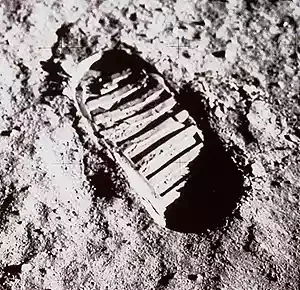We all want to know more about the outer Space but we always don't have much of the opportunity to. Am taking this opportunity to give a full detail writing about the first moon landing
In September 1968, the Russian unmanned craft zond 5 successfully flew round the moon, returning safely to the earth, splashing down in the India ocean. This notable feat was followed in November by the equally successful zond 6. It was later revealed that the zond craft had contained living creatures such as miniature turtles and that these had not suffered any harm on their 500,000-mile voyage apart from a slight loss in weight. Manned flight seemed more feasible.
In October,the Americans had made a successful manned ten day earth flight if their Apollo 7 spacecraft, a prototype of the vehicle to be used for lunar flights.
On 21 December 1968, the scene was set at cape Kennedy For the blast off to man's first flight to the moon, the Apollo 8 mission. The three men space capsule stood atop the mighty 363-foot Saturn 5 rocket, crewed by Colonel frank Borman, captain James Lovell, and major William anders, as the world watched on satellite relayed television.
At 7.51 a.m. eastern standard time. The five engines of the Saturn 5 first stage successfully ignited. The firing was so accurate that only one small course adjustment was necessary during the flight towards lunar interception. During the flight the crew relayed direct television pictures of sights never seen before by man_ the earth as seen from space.
The next crucial point came as Apollo 8 neared the moon. Because of the effects of the earth's gravitational pull, the spacecraft slowed down steadily until it reached a distance where the moon's gravitational pull exactly balanced that of the earth. Thereafter the craft accelerated under the effect of the moon's gravity to a speed of 5,750 miles per hour. As Apollo 8 passed round the far side of the moon, it was necessary to fire the rocket to slow the vehicle down to lunar orbital velocity,about 3,600 miles per hour.
A mistake at this stage could have been fatal. They made 9 orbits of the moon taking valuable colour photographs and sending back spectacular television pictures. one of the major aims of the expedition was to make a visual survey of possible sites for a visual lunar landing
The next morning Apollo 8 passed behind the moon for the tenth time and the rocket motors were once again fired for just over four minutes to accelerate the space craft past lunar escape velocity and back towards the earth. Apollo 8 made a perfect re- entry back to the earth, with the aid of parachutes, the craft finally landed gently in the pacific ocean.
Although the Apollo 8 flight was a tremendous technical and human achievement, it is nevertheless true that it added very little to the sum of our knowledge of the moon an planets. The flight was important as a necessary preliminary to manned lunar landings.
THE FIRST MANNED LUNAR LANDING
Image source:google

The two subsequent Apollo missions tested the lunar module which was to take men to the surface of the moon. Apollo 11 in July 1969 was the first attempt at a manned lunar landing and was a brilliant success. The Saturn rocket boosted the command and service module and lunar module toward the moon. In lunar orbit, astronauts Neil Armstrong and Edwin aldrin crawled through a hatch from the command module into the lunar module
.png) image source:google
image source:google
THE LUNAR MODULE
The lunar module separated from the command module and defended to the lunar surface leaving Michael Collins orbiting alone in the CM(command module )
Using its motors to slow its decent and guide it to a clear site, Armstrong skilfully landed the lunar module on the sea of tranquility. The astronauts looked out upon a plain pitted with craters and littered with boulders of various sizes. Dressed in his bulky pressurized suit, Neil Armstrong opened the hatch and carefully descended a short ladder to the lunar surface. He found that the surface was firm and that he could walk about fairly easily.

_image source google
the first footprint on the moon
The world watched his movements on television,Armstrong became the first man to walk on Moon. Armstrong gathered some rock samples in case they had to leave suddenly. After lowering equipment from the lunar module, aldrin joined Armstrong on the lunar surface the astronauts gathered sample of rock and dust for distribution to scientist throughout the world for detailed analysis, they set up a number of equipment including a seismograph and an aluminum foil screen to record the solar wind, the stream of charged particles emitted by the sun,
.jpg)
the alluminium screen aldrin placed to measure the solar wind
and took many excellent colour photographs of the equipment, the lunar module and themselves.
Probably the riskiest manoeuvre was the lift off in the lunar module from the from the surface of the moon and the rendezvous with the command module orbiting 70 miles up. The manoeuvre went perfectly, the two craft docked, and Armstrong and Aldrin rejoined Collins in the command module. The lunar module was then disconnected and sent off into lunar orbit, and the command module returned to earth and splashdown in the pacific